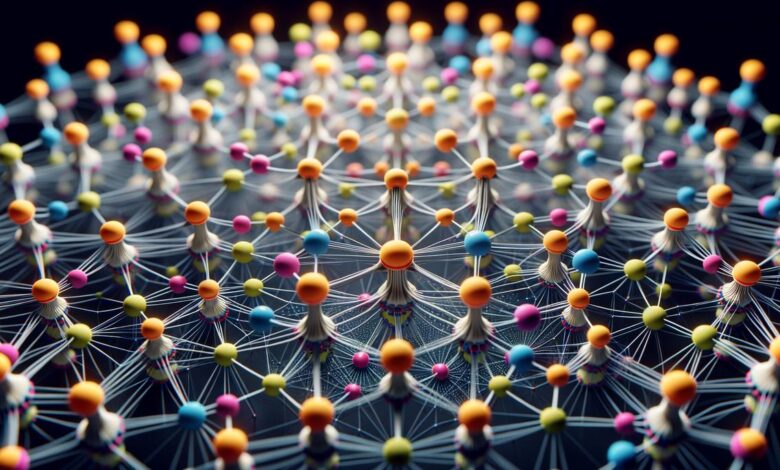
What is a Recurrent Neural Network?
Recurrent Neural Networks (RNNs) are designed to process sequential data by utilizing an internal memory. Unlike feedforward neural networks, RNNs can remember previous inputs, making them suitable for tasks where context is important, such as language translation and speech recognition.
Key elements of an RNN include:
- Input layer
- Hidden layer
- Recurrent connections
The hidden layer processes input at each time step, combining it with the previous state from the recurrent connection. This recurrence creates a loop within the network, allowing it to consider past inputs in its current processing.
RNNs process each input with the same set of parameters, which makes them computationally efficient. They are trained using backpropagation through time (BPTT), which updates weights based on errors calculated at each time step.
However, RNNs can face challenges like vanishing and exploding gradients during training. Variants such as Long Short-Term Memory (LSTM) networks have been developed to address these issues and enhance the network's ability to handle long-term dependencies.
How RNNs Work
RNNs consist of an input layer, hidden layer, activation functions, and output layer. The process begins at the input layer, where sequential data points are received. The hidden layer maintains a "hidden state," which acts as the network's memory of previous inputs.
The hidden state is updated using an activation function, typically hyperbolic tangent (tanh) or Rectified Linear Unit (ReLU). The update formula is:
ht = σ(Wih · xt + Whh · ht-1 + bh)
Where:
htis the current hidden statextis the current inputht-1is the previous hidden stateWihandWhhare weight matricesbhis the biasσis the activation function
The output layer then converts the hidden state into the final output:
yt = σ(Who · ht + bo)
Where:
ytis the outputWhois the output weight matrixbois the bias
This cycling of information through the layers creates a loop that maintains context across different time steps, allowing RNNs to handle temporal dependencies effectively.
RNN Architectures and Variations
RNN architectures can be categorized based on their input-output configurations:
- One-to-One: Single input to single output, similar to feedforward networks.
- One-to-Many: Single input produces a sequence of outputs (e.g., image captioning).
- Many-to-One: Sequence of inputs generates a single output (e.g., sentiment analysis).
- Many-to-Many: Sequences of inputs produce sequences of outputs (e.g., machine translation).
Advanced RNN variants include:
- Long Short-Term Memory (LSTM): Incorporates memory cells and gates to address the vanishing gradient problem and handle long-term dependencies.1
- Gated Recurrent Unit (GRU): A simplified version of LSTM with merged gates, offering faster training and comparable performance.2
- Bidirectional RNNs: Process input sequences in both forward and backward directions for comprehensive context understanding.
- Deep RNNs: Stack multiple layers of recurrent connections to capture more abstract representations of data.
These variations enhance RNNs' ability to process complex sequential data in various applications, from natural language processing to video analytics. Recent studies have shown that LSTMs and GRUs can outperform traditional RNNs in tasks requiring long-term memory.3
Challenges and Solutions for RNNs
Recurrent Neural Networks (RNNs) face significant challenges, primarily the vanishing and exploding gradient problems. These issues can severely impact their performance, especially when dealing with long-term dependencies.
The vanishing gradient problem occurs when gradients used to update the network's weights become very small during backpropagation, causing the network to stop learning effectively. Conversely, the exploding gradient problem happens when gradients become excessively large, leading to unstable weight updates and potential numerical instability.
Several solutions have been developed to address these issues:
- Long Short-Term Memory (LSTM) networks: LSTMs incorporate memory cells and three types of gates (input, forget, and output) to manage information flow more effectively.
- Gated Recurrent Units (GRUs): GRUs simplify the LSTM architecture by combining the input and forget gates into a single update gate and using a reset gate to control information retention.
- Gradient clipping: This technique sets a threshold for gradients, scaling them down if they exceed this threshold during backpropagation.
- Backpropagation Through Time (BPTT): This training method unrolls the RNN over time steps and applies standard backpropagation, often paired with other techniques to improve learning stability.
These advancements have made RNNs more capable of handling complex sequential data tasks, maintaining their importance in deep learning applications.
Applications of Recurrent Neural Networks
RNNs have found numerous applications across multiple industries due to their proficiency in handling sequential data. Some key applications include:
| Application | Description |
|---|---|
| Speech recognition | Converting spoken language into written text, used in voice-activated assistants. |
| Machine translation | Translating text from one language to another while maintaining context and meaning. |
| Text generation | Creating coherent and contextually relevant text for chatbots, content creation, and creative writing. |
| Time series forecasting | Predicting future values based on past trends in fields like finance and meteorology. |
| Anomaly detection | Monitoring sequences of data for unusual patterns in areas such as network security and manufacturing. |
| Medical diagnosis | Analyzing sequential data like ECG signals or patient histories to aid in disease detection. |
| Music generation | Creating new musical compositions by learning from existing datasets. |
| Video captioning and image recognition | Combining RNNs with Convolutional Neural Networks to process both spatial and temporal data. |
These applications showcase the versatility of RNNs in processing and understanding sequential data across various domains.
Implementing RNNs with Python
Implementing RNNs with Python involves several steps:
- Prepare the development environment:
pip install tensorflow keras
- Data Preparation:
import numpy as np
data = np.array([i for i in range(50)])
def create_dataset(data, step):
X, y = [], []
for i in range(len(data) - step):
X.append(data[i:i + step])
y.append(data[i + step])
return np.array(X), np.array(y)
step = 5
X, y = create_dataset(data, step)
X = np.reshape(X, (X.shape[0], step, 1))
- Building the RNN Model:
from tensorflow.keras.models import Sequential
from tensorflow.keras.layers import SimpleRNN, Dense
model = Sequential()
model.add(SimpleRNN(50, input_shape=(step, 1), activation='relu'))
model.add(Dense(1))
model.compile(optimizer='adam', loss='mean_squared_error')
- Training the Model:
split = int(len(X) * 0.8)
X_train, X_test = X[:split], X[split:]
y_train, y_test = y[:split], y[split:]
model.fit(X_train, y_train, epochs=100, batch_size=1, verbose=2)
- Evaluating the Model:
from sklearn.metrics import mean_squared_error
y_pred = model.predict(X_test)
mse = mean_squared_error(y_test, y_pred)
print("Mean Squared Error: ", mse)
- Visualizing Results:
import matplotlib.pyplot as plt
plt.plot(y_test, label='True Values')
plt.plot(y_pred, label='Predicted Values')
plt.title('True vs Predicted Values')
plt.legend()
plt.show()
This implementation demonstrates the basic process of creating, training, and evaluating an RNN model for sequence prediction using Python and Keras.
Recurrent Neural Networks (RNNs) are valuable for processing sequential data effectively. Their architecture, which includes maintaining an internal state and reusing weights across time steps, makes them particularly suitable for tasks requiring context and temporal understanding. Recent studies have shown that RNNs can achieve state-of-the-art performance in various natural language processing tasks, outperforming traditional methods by a significant margin.
Unlock the power of AI with Writio! Your article was crafted by Writio.


